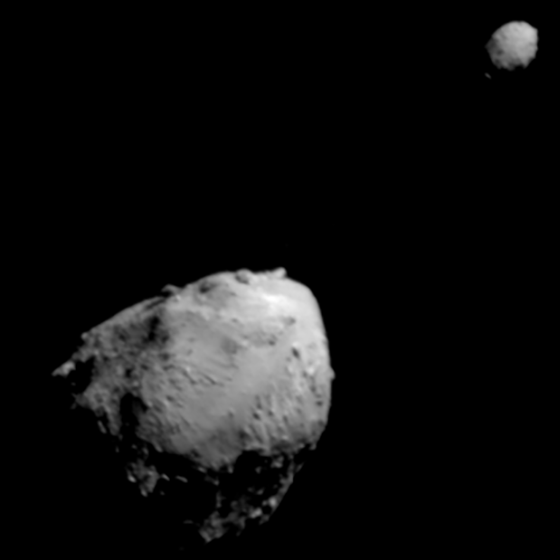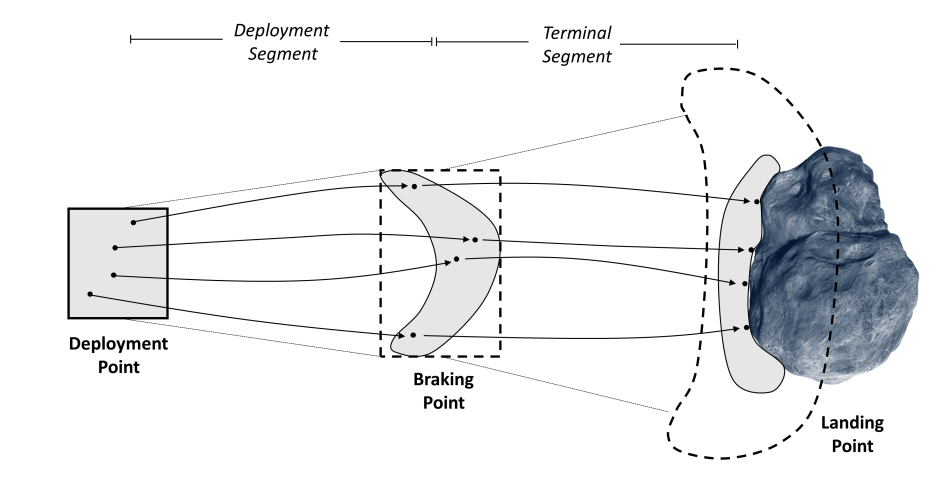In about one year from now, the European Space Agency will launch its Hera mission. Its destination is the asteroid Didymos, and it’ll be the second human spacecraft to visit the 390-meter chunk of rock. NASA’s DART mission crashed a kinetic impactor into Didymos’ tiny moonlet Dimorphos as a test of planetary defence.
Hera will perform a follow-up investigation of the binary asteroid to measure the size and morphology of the impact crater on Dimorphos. To help it along, it’s taking two tiny CubeSats that will land on Dimorphos.
It might seem strange that two tiny satellites will perform landings on an asteroid. But Hera is designed to fulfill different goals. First of all, it’s part of the ESA’s Planetary Defence program. So, its main mission is to study the effect NASA’s DART mission had on Dimorphos and Didymos so we can learn more about deflecting dangerous asteroids that might threaten Earth. But it’s also a technology demonstration mission.
The pair of CubeSats could test a new method of landing on an asteroid called Robust Ballistic Landings.
Landing something on a spinning asteroid with almost no gravity is tricky. If you want to spend a lot of money on a complex spacecraft, you can get good results. But can it be done with less expense and with less complexity and still be successful? That’s what the CubeSats Milani and Juventus will try to do.
The pair of CubeSats are identical except for their instruments. They’re approximately 12 kgs (26.5 lbs), are three-axis stabilized, and have cold gas propulsion systems. They’ll use their instruments to complement Hera’s study of the binary asteroid. Their instruments include a spectrometer, a thermogravimeter for detecting volatiles and organics, a radar to probe Dimorphos’ inner structure, and a gravimeter. There are also cameras and radio equipment. Hera, Milani and Juventus will examine Dimorphos and Didymos for about six months.
Then, at the end of their mission, the plan is for Milani and Juventus to land on Dimorphos.
A new paper presents a novel method the CubeSats can use to land on Dimorphos. Its title is “Design and Analysis of Robust Ballistic Landings on the Secondary of a Binary Asteroid.” The lead author is Iosto Fodde from the University of Glasgow in the UK.

“Two CubeSats on board Hera plan to perform a ballistic landing on the secondary of the system, called Dimorphos,” the authors write. “For these types of landings, the translational state during descent is not controlled, reducing the spacecraft’s complexity but also increasing its sensitivity to deployment maneuver errors and dynamical uncertainties.”
What’s a Robust Ballistic Landing? Basically, it means it’s not a powered descent.
There’s a lot of math involved, but it boils down to what’s called the non-intrusive Chebyshev interpolation (NCI) technique. Basically, a computer calculates the rate of growth of the number of possible states of the CubeSat over time. That lets the spacecraft constrain the number of impact velocities and angles that will allow a successful landing. The result is that the spacecraft can optimize its landing. So, the tiny CubeSat can increase the robustness of its trajectory compared to other methods.
“The resulting trajectory increases the robustness of the trajectory compared to a conventional method, improving the landing success by 20 percent and significantly reducing the landing footprint,” the authors of a new paper say.

NASA’s successful asteroid sample-return mission, OSIRIS-REx, amplified how important bringing samples back to Earth is. It was fantastically successful. But it was also a complicated and relatively expensive mission. All that complexity isn’t necessary for every mission. The authors of this paper point out how simply landing a basic spacecraft on an asteroid can reveal a lot. “Landings on the surface of asteroids are incredibly valuable in terms of scientific return as the spacecraft-surface interaction provides direct information on the internal structure and material properties of the asteroid while their instruments can do some in-situ measurements to characterize the asteroid in more depth,” they write.
So, developing a reliable way to land on asteroids is part of studying them.

Milani and Juventus will attempt to land on Dimorphos at the end of the Hera mission. By that time, they’ll have detailed information on the surface, including rocks and craters. But Dimorphos is a binary system, and that, along with other things, introduces additional complexity that previous asteroid missions didn’t have to contend with. “The complex dynamics due to the large influence of the primary, the non-spherical shape of both bodies and the low gravitational forces make the landing trajectory design difficult,” the authors explain.
The researchers looked specifically at landing the CubeSats in the same hemisphere as DART’s impact crater. That would require an additional braking maneuver to reduce the landing velocity. The NCI robust ballistic landing method “increased the landing success percentage from 74.3% to 94.7% compared to a trajectory designed without considering the uncertainties.” That’s a significant improvement, the type that gets engineers excited, especially when it doesn’t require more complex spacecraft design.

“This comes at the cost of increasing the mean impact angle and moving the mean landing longitude away from the desired location,” the authors explain. “However, even with these changes, the robust trajectory was found to be much more desirable.”
“These results show the potential of this methodology for the design of a ballistic landing on Dimorphos,” say the authors.


I might have missed it, but if Hera launches as planned, when will these little things arrive @ Dimorphos?